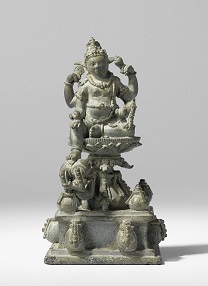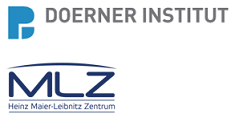Speaker
Description
Neutron-based techniques are very well-suited for non-destructive bulk analysis of large bronzes due to the high penetration depth of neutrons in metals [1]. Neutron tomography (NT) can give direct insights in the internal structure of objects, which can be extremely revealing in cases of inhomogeneous castings, ongoing corrosion or when the bronze contains precious hidden objects, e.g. the Egyptian bronze votive coffins for animal mummies [2]. Gamma spectroscopy (GS) is a powerful, non-invasive method to provide bulk elemental analysis based on characteristic gamma rays induced by the neutrons [3].
The solid-cast bronze Kuvera (AK-MAK-311, height 11.5 cm, weight 488gr, see figure 1) belongs to a small collection of Asian bronze statuary housed by Rijksmuseum Amsterdam; it represents the god of prosperity Kuvera or Jambhala within Hindu and Buddhism culture; it is probably dated to the 9th or 10th century in Java, Indonesia [4]. Since a few years, Rijksmuseum Amsterdam, the Cultural Heritage Agency of the Netherlands (RCE) and TU Delft are collaborating in an investigation of this Kuvera statuette.
Recently, we performed both NT and GS from delayed gammas on this Kuvera statuette, which turned out to have unexpected ‘ritual deposits’ (precious objects) hidden inside. By performing segmentation of such hidden objects in the 3D reconstructed model, we were able to fuse the NT and GS datasets in ray tracing simulations with Geant4. By adjusting the composition of the different segments in the ray tracing, we will show that a self-consistent 3D model can be obtained by comparison of simulated data with both the GS and NT data. Here we will present how the composition of the ‘ritual deposits’ of the Kuvera statuette can be determined using this iterative algorithm, and we believe that this strategy of data fusion of NT and GS of delayed gammas can be applied to many more objects in art and archeology.
[1] Kardjilov N, Festa G, editors. Neutron methods for archaeology and cultural heritage. Berlin: Springer; 2017. http://dx.doi.org/10.1007/978-3-319-33163-8
[2] O’Flynn, D., Fedrigo, A., Perucchetti, L. et al. Neutron tomography of sealed copper alloy animal coffins from ancient Egypt. Sci Rep 13, 4582 (2023). https://doi.org/10.1038/s41598-023-30468-4
[3] Greenberg RR, Bode P, Fernandes EA. Neutron activation analysis: A primary method of measurement. Spectrochimica acta part B: atomic spectroscopy. 2011 Mar 1;66(3-4):193-241. https://doi.org/10.1016/j.sab.2010.12.011
[4] https://www.rijksmuseum.nl/en/collection/AK-MAK-311


